I remember the first time I tried to customize a WordPress login page. It was for a friend’s membership site, and the default WordPress login screen just didn’t align with their brand.
I wanted a solution that was both visually appealing and easy to use. That’s when I started exploring different options and discovered the power of dedicated WordPress login page plugins.
Since then, I’ve used many different plugins across various projects, from simple blogs to complex eCommerce stores. Each site has its own unique needs, and choosing the right plugin can significantly impact user experience and security.
At WPBeginner, we rely on a combination of SeedProd for design and WPForms for secure forms to create a seamless login process. This setup works incredibly well for us, but I understand that every website has different requirements.
That’s why I’ve created this comprehensive guide to the best WordPress login page plugins. Whether you’re running a blog, a membership site, or an online store, this guide will help you find the perfect tool to create a login experience that’s both beautiful and secure.

Overview of the Best WordPress Login Plugins
In a hurry? Here’s a quick overview of our top five picks for the best WordPress login plugins:
| # | Plugins | Best For | Pricing |
|---|---|---|---|
| 🥇 | SeedProd | Building visually appealing login pages | $39.50/yr + Free |
| 🥈 | WPForms | Creating secure login and registration forms | $49.50/yr + Free |
| 🥉 | Theme My Login | Creating a custom login page with an SEO-friendly URL | Free |
| 4 | Temporary Login Without Password | Allowing temporary login | Free |
| 5 | Shield Security | Securing your login page | $129/yr + Free |
That said, I highly recommend you check out the complete list below!
How I Test And Review WordPress Login Plugins
Before recommending any plugin, my team and I test it on real websites, including live demos and staging environments we manage. This helps us go beyond theory and truly understand how a plugin performs in day-to-day use, with different themes, configurations, and traffic conditions.
Here are the criteria that we focused on when testing WordPress login plugins:
✔️ Real-World Experience: I have only recommended plugins I’ve personally tested and used across our WordPress sites. This allows me to confidently speak to their reliability, stability, and performance under pressure.
✔️ Ease of Use: I looked for plugins with intuitive interfaces, minimal setup steps, and clear documentation.
✔️ Security Best Practices: Since login forms are a major target for attacks, I prioritized plugins that follow security best practices. I verified support for features like CAPTCHA, brute-force protection, two-factor authentication, and email alerts.
✔️ Feature Set: Different sites need different login experiences, so I looked for plugins that offer flexible options. This includes custom redirects, social logins, registration forms, and conditional login rules.
✔️ Performance and Compatibility: I analyzed how each plugin affects overall site speed and whether it plays well with caching, themes, WooCommerce, and other popular plugins.
✔️ Ongoing Support and Updates: I checked how frequently the plugin is updated and how responsive the support team is.
✔️ User Feedback: Along with hands-on testing, I read through user reviews and forum threads to identify recurring issues.
Why Trust WPBeginner?
My teammates and I don’t just write about WordPress plugins—we test them on real websites, including our own and those of our partner brands.
When we needed a reliable login solution, we spent a lot of time trying out different plugins to find the right fit. We tested everything from simple login form plugins to complex multi-layer security tools.
Some were too clunky, some broke styling on our pages, and a few even slowed down the site. Eventually, we found a winning combination that worked beautifully: WPForms for secure login forms, and SeedProd for designing branded login pages.
However, I know this setup might not be the ideal fit for everyone, especially if your site has different needs or a tighter budget.
That’s why I also recommend other tools I’ve personally tested—everything listed here is something I trust and would feel confident using on a live site. To learn more, see our editorial process.
Having said that, let’s take a look at some of the best WordPress login page plugins. These can improve your website’s login experience and security.
1. SeedProd
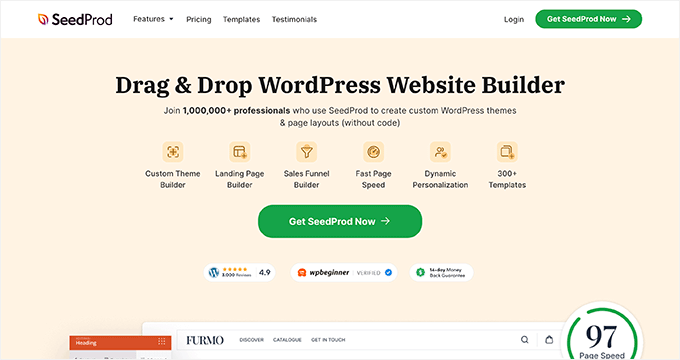
SeedProd is a beginner-friendly theme and landing page builder with a huge library of login page templates. With it, you don’t need to touch a single line of code to create custom pages that actually look good. That’s why it’s my top pick for this list.
Just choose a template you like, and it’ll instantly turn your default WordPress login page into a professional, conversion-friendly design.
Several of our partner brands have designed their entire websites, including login pages, with the tool, and their users have loved it. To learn more, see our detailed SeedProd review.

You can also use SeedProd to create custom login pages that cross-promote your other products, show existing users loyalty discounts, introduce new products, and more.
One of the standout features I love about the plugin is its ability to fully customize login forms to suit your site’s needs. You can add your own logo, change colors, customize buttons, fields, text, and so much more to create a truly unique login experience.

Another feature I found to be super useful is the ability to set up custom redirects after a user logs in.
It can be handy when you need to ensure that members are sent directly to their account dashboards or a specific landing page after logging in.
In my experience, this can boost user engagement by making it easy for visitors to be redirected to relevant content right after they sign in.

All that said, my favorite thing about SeedProd is that it integrates perfectly with WPForms, so you can use the two tools together to create an eye-catching login page with a secure login form (more on that in the next section).
Overall, SeedProd is a great choice for blogs, membership sites, business sites, and eCommerce stores that want to create attractive login pages.
For more instructions, see our tutorial on how to customize the WooCommerce login page.
Pros of SeedProd
- SeedProd includes a login form block, which makes it super simple to add a custom form to your login page template.
- The plugin has mobile-friendly templates, ensuring that users have a smooth experience no matter what device they use to log in.
- I love its AI builder, where you just need to provide a prompt, and SeedProd creates an entire website based on it.
- You can also use its dynamic content feature to create a more personalized login page.
- It has easy integration with email marketing services to grow your email list.
Cons of SeedProd
- The plugin has a free plan, but some of the features will only be available in the pro version.
Why I recommend SeedProd: If you want to design a visually appealing and secure login page that matches your brand, SeedProd is the ultimate choice.
2. WPForms
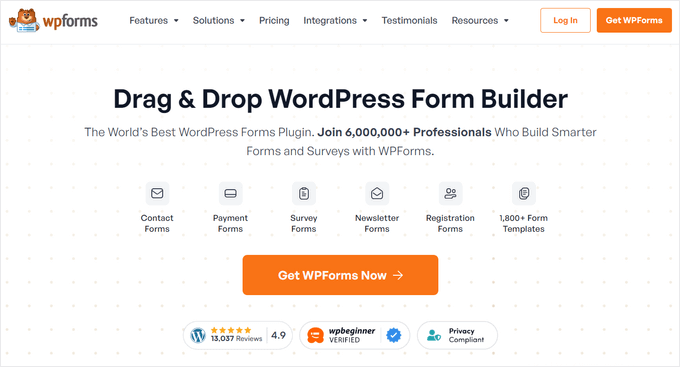
WPForms is the best WordPress form builder plugin. It comes with a powerful user registration addon that makes creating custom login and registration forms a breeze.
With just a few clicks, you can design fully customized user registration forms and login forms without needing to touch any code. This addon integrates seamlessly with your WordPress site, ensuring a smooth user experience for both admins and site visitors.
Several of our partner brands have created their login forms, surveys, and contact forms using it, and they’ve had a completely secure experience. For more details, see our complete WPForms review.
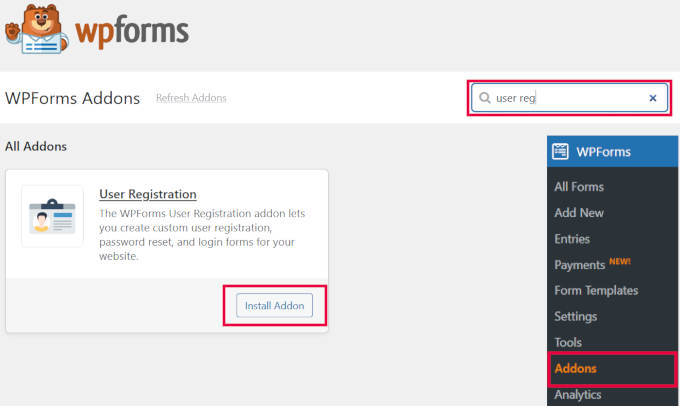
Whether you’re looking for a simple username and password login or a more complex registration form, WPForms lets you add or remove fields with just a few clicks.
Another feature I appreciate is the ability to use conditional logic in forms. This gives you more control over the information you collect from users, as you can show or hide fields based on their input.
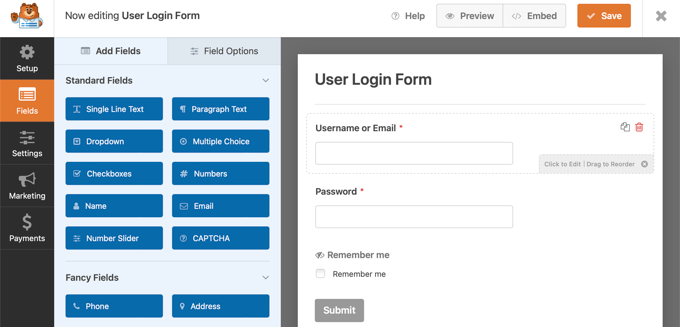
After a user registers or logs in, WPForms also makes it easy to set up email notifications.
I’ve used this feature to confirm registrations, send login details, and even send welcome emails to new users. It saves me time and ensures that users receive the right information immediately after they sign up or log in.
For detailed instructions, see our guide on how to create a custom login page in WordPress.
Pros of WPForms
- You can use your registration forms to accept payments with Stripe or PayPal.
- WPForms includes built-in anti-spam features, like CAPTCHA and honeypot fields. This ensures that your login and registration forms are secure from bots.
- It has an AI-powered form builder. If you can’t find a login template that fits your needs, this builder can automatically generate a form based on your requirements.
- What I really love about WPForms is how it lets you manage all form submissions right from your WordPress dashboard. With just a few clicks, you can view, filter, and export entries without any hassle.
- The plugin lets you track and analyze form submissions, which can be useful for understanding user behavior and improving your forms.
Cons of WPForms
- It has a free plan. However, you will need the Pro plan to unlock the user registration addon.
Why I recommend WPForms: If you want to create a secure login form without any hassle, WPForms is the solution for you.
3. Theme My Login

Theme My Login is a popular plugin for creating custom WordPress login pages. It can also be used to let users register on your WordPress site without accessing the admin area.
After thorough testing, I believe it’s an ideal solution for beginners on a budget since it is highly intuitive to use and it’s completely free.
The tool allows users to log in, register, and recover passwords directly from the front end, maintaining the site’s aesthetic and user flow.
All you need to do is visit the WordPress block editor and add the suitable shortcode for your login or user registration form.
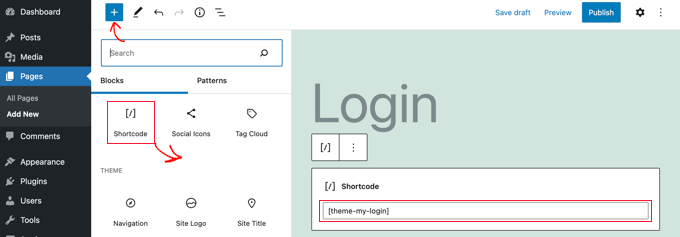
What sets it apart, in my opinion, is Theme My Login’s ability to customize the URL slugs for login, registration, and password recovery pages.
This level of flexibility allows you to choose slugs that best suit your site’s branding and user experience, creating a more professional feel across the site.
Plus, this setting improves SEO. Custom slugs like /user-login, /register, and /password-reset are far more descriptive and SEO-friendly than the default WordPress URLs, like /wp-login.php.
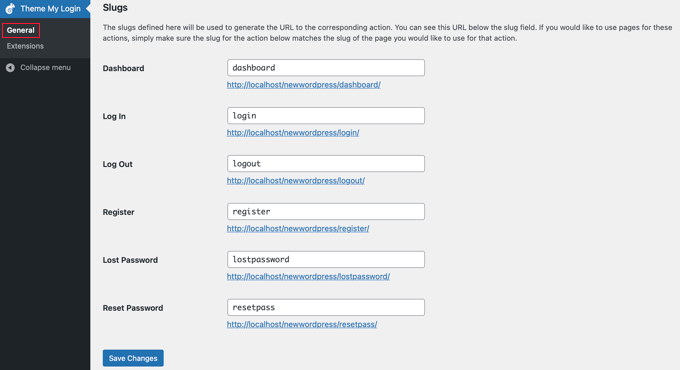
For more details, see our guide on how to create a custom login page using Theme My Login.
Pros of Theme My Login
- The plugin offers users the option to register using only their email address, simplifying the registration process.
- I like that it supports multiple login methods, including email and password, username and password, or a combination of both.
- It has a Restriction extension that lets you restrict access to posts, pages, widgets, and navigation menu items based on a user’s login status and role.
- Theme My Login lets you moderate user registrations by requiring email confirmation or admin approval.
Cons of Theme My Login
- You will need to purchase extensions to add some of the functionalities.
- Depending on the theme you’re using, the frontend login and registration pages might not always blend perfectly. They may require additional styling tweaks to maintain consistency with your site’s design.
Why I recommend Theme My Login: If you want to create a custom login page with a more SEO-friendly URL, then Theme My Login is a great option.
4. Temporary Login Without Password

Temporary Login Without Password lets you give users access to your website without requiring them to create an account. You can also set an expiry date or time for the temporary login or delete it at any time.
When testing the tool on my demo site, I liked that it allows you to generate unlimited temporary login links, each with customizable roles and access levels.
This makes it an ideal plugin for various websites where controlled, short-term access is needed without sharing passwords.
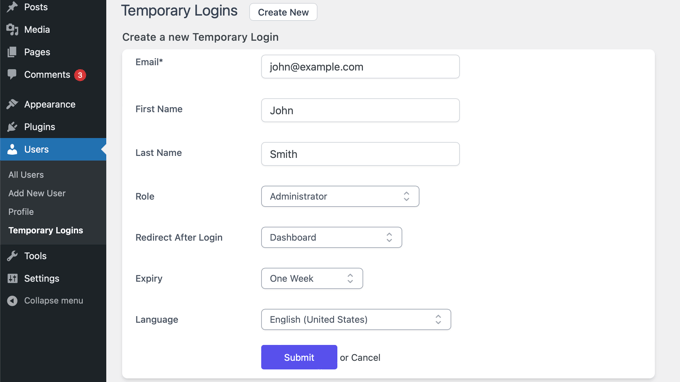
Client websites, development and staging sites, eCommerce platforms, membership sites, online courses, event websites, freelancer sites, and collaborative projects all benefit from this feature.
It allows you to grant external users, collaborators, or developers secure access without the hassle of creating permanent accounts, ensuring a secure user experience.
For detailed instructions, see our guide on how to create a temporary login for WordPress.
Pros of Temporary Login Without Password
- I was really impressed that the plugin lets you set specific expiration times for each login link, such as one day, one week, one month, or a custom date.
- The tool is completely free.
- During testing, I discovered that it assigns a preferred language to temporary users.
- The plugin lets you track the last login time and the number of times a temporary user has accessed your site.
Cons of Temporary Login Without Password
- Providing temporary access without passwords can pose security risks if not managed carefully.
Why I recommend Temporary Login Without Password: If you want to allow temporary access to developers or collaborators, then this plugin is ideal.
5. Shield Security

Shield Security, formerly known as WP Simple Firewall, is a WordPress security plugin designed to protect your site from various threats.
One of its standout features is the silent CAPTCHA, an invisible bot-detection system that safeguards login, registration, and password reset forms without disrupting the user experience.
It can effectively block malicious bots attempting brute-force attacks and prevent spam registrations. The plugin also offers bot and IP blocking capabilities to block repeat offenders.
It also has features to stop comment spam, help you control automated WordPress updates, and more.
Pros of Shield Security
- When testing the tool, I found that it has an activity log that tracks all WordPress actions, including changes made directly to the database.
- It supports two-factor authentication for all users, adding an extra layer of security to your login page.
- It lets you set restrictions on the number of failed login attempts.
- The tool’s Security Admin Protection feature allows you to restrict access to the plugin’s settings, preventing unauthorized modifications.
Cons of Shield Security
- It has many other security features that may not be useful if you are already using another security solution like Cloudflare or Sucuri.
- Some users have complained about the customer support not being great.
Why I recommend Shield Security: If you want to limit login attempts, add a silent CAPTCHA to login pages, offer 2FA, and secure your site, then I recommend Shield Security.
6. Nextend Social Login
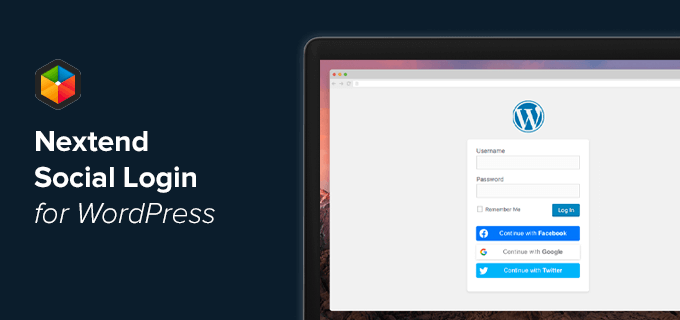
Nextend Social Login lets users log in to your WordPress site using Facebook, Google, or Twitter. This allows them to log in more quickly because they won’t have to create a separate password for your site.
I have thoroughly tested the tool myself, and I found that it integrates smoothly with existing WordPress login and registration forms. One feature that stood out to me was the customizable redirects.
After users register or log in, you can direct them to specific pages on your site, such as a dashboard or welcome page, which I’ve found helpful for improving the user experience.
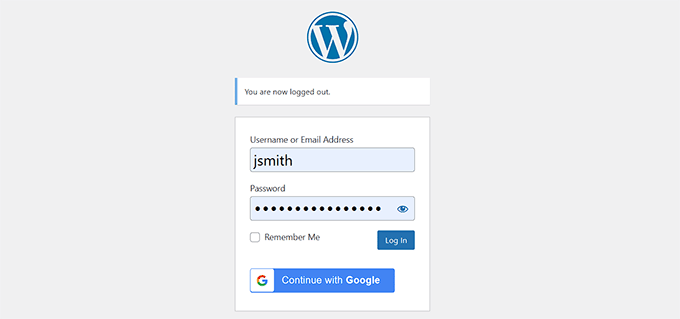
Additionally, you can boost personalization with the profile picture display.
When users log in via their social accounts, their profile pictures are automatically pulled in and displayed as avatars. This adds a touch of individuality to the user experience and makes the site feel more personal and engaging.
To get started, see our tutorial on how to add social login to WordPress.
Pros of Nextend Social Login
- The plugin allows you to customize the look of the login buttons to fit your site’s theme.
- You can control which user roles can use social login.
- Nextend Social Login allows users to link or unlink their social accounts directly from their WordPress profile page.
- The plugin enables social login for your site’s comment section.
- It can easily integrate with WooCommerce.
Cons of Nextend Social Login
- Most of the advanced features are only available in the pro plan.
- Setting up social login requires creating developer accounts with Facebook, Google, and other providers, which can be time-consuming.
Why I recommend Nextend Social Login: If you want to allow users to log in to your site with their Facebook, Google, or X (Twitter) account, then Nextend Social Login is the best solution.
7. WordPress Persistent Login
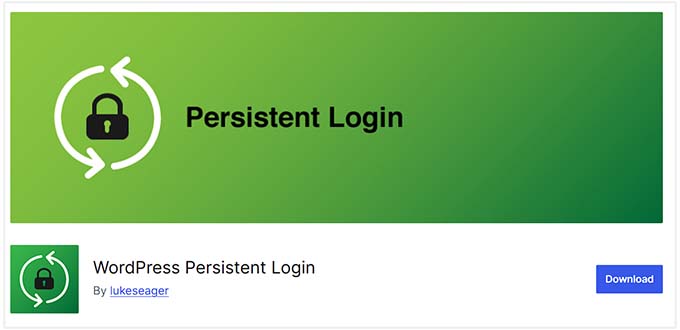
WordPress Persistent Login is a user-friendly WordPress plugin that keeps users logged into your website unless they explicitly choose to log out.
It keeps users logged in for up to one year by selecting the ‘Remember Me’ checkbox by default on all login forms. Each time a user revisits your website, their login is extended to one year.
If you’re running a membership site, then these settings will also apply to your users.
When trying out the tool, I discovered that it also allows you to limit the number of active logins per user.
When the limit is reached, you can choose to block new logins, automatically log out the oldest session, or let the user decide which session to end.
Pros of WordPress Persistent Login
- The plugin lets users view and manage their active sessions from their Profile page, including details like device type and last active time.
- It notifies users of logins from new devices, providing an added layer of security.
- It supports popular plugins, including WooCommerce, Theme My Login, and Ultimate Member.
- It provides insights into how many users are being kept logged in, helping you monitor user engagement and session activity.
Cons of WordPress Persistent Login
- Some users have complained that the plugin has compatibility issues with Yoast SEO.
- Sometimes, the login session reports are not accurate.
Why I recommend WordPress Persistent Login: If you want to keep users logged in on your site, then I recommend this plugin.
8. Custom Login Page Customizer

Custom Login Page Customizer lets you design your own custom login page using the WordPress theme customizer.
Its user-friendly interface ensures that both beginners and advanced developers can easily tailor the login experience without any coding knowledge.
You can modify every aspect of your login page, including the logo, background color, text color, font size, and button styles.
Plus, I love that you can instantly view changes in real-time, facilitating quick adjustments to achieve the desired appearance.
Pros of Custom Login Page Customizer
- During testing, I found that you can also add custom CSS to refine the login page’s appearance further.
- The tool is compatible with WordPress multisite installations.
- I like that the plugin lets you upload your logo and background images.
- You can also choose from various color schemes or create your own.
Cons of Custom Login Page Customizer
- When reading user reviews, I discovered that it does not provide great customer support.
- It may have compatibility issues with any other login page design plugins.
Why I recommend Custom Login Page Customizer: If you want to design your login page for free, then Custom Login Page Customizer is a great solution.
9. Simple History

Simple History makes it easy to track user activity on your WordPress site, including user logins. It keeps an easy-to-understand user activity log, which is handy for protecting your website.
The plugin lets you see when users logged in and what they did during their session. You can also see when they logged out.
In addition, it tracks post and page updates, media uploads, taxonomy changes, comment moderation, widget modifications, plugin activations/deactivations, user profile changes, and failed login attempts.
It also tracks changes to site settings like the site title and permalink structure. For more details, see our guide on how to monitor user activity in WordPress.
Pros of Simple History
- You can log custom events using the plugin’s API. This allows for tracking specific actions or changes within the site.
- You can view the activity logs through a dashboard widget, a dedicated admin page, or RSS feeds.
- Admins can restrict access to the activity logs.
- It is a lightweight tool that doesn’t affect your site speed.
Cons of Simple History
- It does not have great support.
- Simple History is not ideal for large websites with heavy traffic or many contributors because the database can grow quickly and slow down your site.
Why I recommend Simple History: This is an ideal solution for tracking user activity, such as login/logout sessions and failed login attempts.
10. Password Protected

Password Protected allows you to easily make your whole WordPress site password-protected. You can enable admins and logged-in users to view it. You can also create a master password to share with others.
Additionally, you can improve your site security by adding Google reCAPTCHA to the password entry screen, reducing brute-force attacks and spam.
For step-by-step instructions, see our guide on how to password protect your WordPress site without user registration.
Pros of Password Protected
- I love that the plugin allows you to determine how long the password remains valid, controlling user session durations.
- It prevents brute-force attacks by restricting the number of login attempts from a single IP address.
- The plugin lets you choose which user roles can access the site without entering a password.
- You can also grant access to specific IP addresses, allowing trusted users to bypass the password requirement.
Cons of Password Protected
- Since there’s just one shared password, there’s no way to know which visitor accessed the site. This can be a security risk, especially for sensitive or private client work.
- I don’t like that the password screen is extremely basic and doesn’t match the look and feel of your brand.
Why I recommend Password Protected: If you want to create a single master password that everyone can use to access your website, I recommend the Password Protected plugin.
11. LoginWP

LoginWP allows you to redirect users to any page on your website after they log in. You can set up these redirects based on user roles and capabilities.
It can also be used to set up redirects for individual users. This could be useful if several people are working on different parts of your site.
The plugin also allows you to set up redirects for user registration forms. This way, you can properly greet newly registered users, give them instructions about the next step, or simply show them a thank-you note.
For more details, see our article on how to redirect users after successful login in WordPress.
Pros of LoginWP
- The plugin allows you to create custom URLs for redirects.
- It seamlessly integrates with plugins such as WooCommerce, Gravity Forms, WPForms, LearnDash, MemberPress, and more.
- You can also choose to redirect users to a specific URL only upon their first login.
Cons of LoginWP
- Some of the features are only available in the pro plan.
- Some users have complained about poor customer support.
Why I recommend LoginWP: If you want to redirect users to different pages upon login, then I recommend LoginWP.
Which Is the Best WordPress Login Page Plugin?
I believe SeedProd is the best WordPress login page plugin. It lets you set up an attractive custom login page in just a few clicks and is easy for beginners. Plus, it easily integrates with WPForms.
WPForms is another great option if you’re looking for an overall form builder. It comes with ready-made templates for user registration forms, login forms, and more. It is secure, easy to use, and budget-friendly.
However, if you just want to create a simple login page with an SEO-friendly URL, then I recommend Theme My Login.
Similarly, Temporary Login Without Password is great for allowing developers or collaborators temporary access to your site.
I think Nextend Social Login is also a great option for allowing users to log in with their social media accounts like Google, Facebook, Twitter, and more.
Frequently Asked Questions About WordPress Login Plugins
Here are some questions that are frequently asked by our readers about WordPress login plugins.
Do I need a login plugin for my WordPress site?
You might not need a login plugin if you are running a simple blog or portfolio site with just one or two users.
However, if your site allows user registration, sells products, or has a membership area, a login plugin can make a huge difference.
It gives you better control over the login experience and helps you protect your site with added security features.
So even if you’re not running a huge membership site, the right plugin can improve your site’s professionalism and functionality.
Is it safe to use third-party login plugins?
Yes, it’s generally safe to use third-party login plugins if you choose reputable ones that are regularly updated and well-reviewed.
I always test plugins on staging sites first to make sure they don’t conflict with other tools or slow things down. I also look for plugins that follow WordPress coding standards, have active support, and include essential security features like brute force protection or reCAPTCHA.
When I stick to trusted plugins like WPForms or SeedProd, I’ve never run into security issues.
How do I track user login activity?
To track user login activity on your WordPress site, you can use an activity log plugin like Simple History or WP Activity Log. Both tools can track things like login attempts, plugin changes, content edits, and more.
This kind of tracking can be helpful when working on multi-author sites or client projects. It gives you peace of mind in case something unexpected happens. Plus, you can export the logs or set up alerts for even more control.
Which plugin is best for user registration and login forms?
If you are looking for the best plugin to create user registration and login forms in WordPress, then WPForms is hands-down one of the top choices.
What I really like about it is how beginner-friendly it is—there’s no need to touch code, and you can build fully functional login or registration forms with just a few clicks.
Another thing that sets WPForms apart for me is the added functionality. You can use conditional logic to show fields based on user input and set up email notifications to confirm registrations or welcome new users.
It even supports CAPTCHA for spam protection and has built-in support for redirecting users after login or registration.
Best WordPress Guides to Improve Your Login Page
I hope this article helped you find the best WordPress login page plugins for your website. You may also want to check out these guides to improve the WordPress login page experience further:
- How to Add One-Click Login With Google in WordPress
- How to Add a Login Form in Your WordPress Sidebar
- Beginner’s Guide: How to Find Your WordPress Login URL
- How to Remove the Remember Me Option from WordPress Login
- How to Add Passwordless Login in WordPress with Magic Links
- Beginner’s Guide to Bypassing WordPress Login (Expert Tips)
- How to Add Front-End Login Page and Widgets in WordPress
If you liked this article, then please subscribe to our YouTube Channel for WordPress video tutorials. You can also find us on Twitter and Facebook.





Jiří Vaněk
I’m just discovering what Seed Prod can do. Do you have instructions somewhere on how to use the builder to create a login page? If not, I’ll try to find a way myself. Seed Prod is the perfect tool.
WPBeginner Comments
Yes, we happen to have a guide on how to use SeedProd to make a custom login page here: https://www.wpbeginner.com/plugins/how-to-create-custom-login-page-for-wordpress/#seedprodloginpage
Jiří Vaněk
Amazing. Many thanks for the reply and the link. I’m going to check it out and try it out. You are awesome.
Farhan Malik
I want to create login after home page appearnce
When some come to my web, he should see home page, then any other option he choose, he must login.
Is there ant plugin or tutorial related to this
WPBeginner Support
For what it sounds like you’re wanting, you would want to use a membership plugin, we recommend a few here: https://www.wpbeginner.com/plugins/5-best-wordpress-membership-plugins-compared/
Admin
Purnendu
Do Theme My Login support Multisite properly???
Liza Koshy
my blog has got deleted while using wordpress reset plugin. how will i get it back.
WPBeginner Support
If you were using a backup plugin then you can restore your website from the backup. You can also ask your WordPress hosting provider and they might have a backup of your WordPress database which you can then use to restore your website.
Admin
Ďeepak
How to create a theme like your on genesis